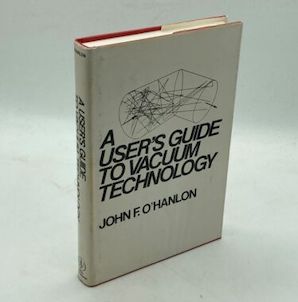
-----
Need help with Titanium Nitride TiN coatings
Q. I am trying to coat a glass or silicon substrate with Titanium Nitride. Is it possible to evaporate Titanium in a let's say 10^-5 or less mbar Nitrogen atmosphere in order to get a nice thin layer of TiN on my substrate? Has anybody done that before?
Andrei HonciucUofA - Tuscaloosa, Alabama
2005
by John F. O'Hanlon

on eBay or Amazon
or AbeBooks
(affil link)
Q. I am coating TiN (PVD golden) on glass surface but TiN coating mostly remove or fails after some hours of coating.
Coating parameters are: temperature 150-160 °C, vacuum during deposition coating 1.0E-1 pa. I want to know how can I coat glass with good adherence?
new delhi vacuum coating - Hyderabad .pk
March 25, 2018
A. Yes, it is difficult to coat TiN on glass whereas it is straightforward to deposit Ti on it. My experience is that immediately after coating TiN looks beautiful on glass. But pretty soon it shrinks, cracks and crumbles into tiny flakes. I guess it is due to built in stresses both in glass and TiN and a mismatch in the crystalline properties. In fact it is not possible to deposit even gold directly on glass. But commercially it ( I.e TiN as well gold) is routinely done. I think one could try the following:
1. Pay utmost attention to pre cleaning and in situ cleaning and ion etching.
2. I don't know the technique you are using for depositing TiN. Unbalanced magnetron might be more suitable than others.
3. An inter layer of either Cr or Ti helps in depositing gold on glass. You may try this. I use cathodic arc technique. Ti inter layer was not of any help. But there are a number of factors.
4. It may also depend on the type of glass one uses. I guess it would be much easier to coat on quartz because of its crystalline properties.
5. Deposition temperature is another important factor.
Good luck! Please share your experience.
Bangalore Plasmatek - Bangalore Karnataka India
April 8, 2018
Q. Thank you dear Prabhakara H.R. for replying to me.
I am using cathodic arc source. Could you tell me about pulse bias power supply or ion etching for cleaning purpose before coating TiN?
I have DC power supply 40kw -- can it be used for cleaning in chamber?
I hope for reply from you soon.
- Hyderabad, Pakistan
April 10, 2018
Q. Sir. I am coating TiN on glass products with cathodic arc source but TiN coating become fail after some hours, could you suggest me which plasma cleaning is appropriate for cleaning in the vacuum chamber before coating for my machine, machine size is 2000 * 2600 mm.
hasan laraib [returning]- Hyderabad, Pakistan
April 10, 2018
A. I don't have any ready-made answer. You have a really big machine. I don't know what is the glass object you are trying to coat, configuration of the machine, purpose of coating, your current cleaning steps etc. However you cannot apply a DC bias to glass as it is not electrically conducting. In principle one can apply RF bias. But it may not be practical in such a big machine. You may perhaps generate a glow discharge using the DC supply and expose the glass objects to the plasma thus generated before coating TiN. The manufacturers of the machine could be of some help.
H.R. PrabhkaraBangalore Plasmatek - Bangalore, Karnataka, India
April 11, 2018
Q. I have a cathodic arc PVD machine, it has 34 targets installed. My question is when I start coating and turn on the power to targets my targets sometime on and then off again on and then off?
Can anyone help me to identify this problem ?
new delhi vacuum coating - Hyderabad .pk
June 15, 2018
A. Often a cathodic arc tends to go off and the machine is designed to automatically re-trigger it. It depends on the nature of the target material, operating conditions like gas, pressure, current, target condition etc. It would be a problem if it happens too (?) frequently. It could also be indicating that the target is worn out and a replacement is required. The operator has to develop an instinct for these things !
Prabhakara H.R.Bangalore Plasmatek - Bangalore, Karnataka, India
June 24, 2018
Q. Thank you mr. prabhakara ... I need to know what is the purpose of trigger in cathodic arc source and if I take the magnet out from the cathodic arc source then what will be the result?
hasan laraib [returning]- Hyderabad, sindh, Pakistan
August 31, 2018
A. Experience is the best teacher. Take out the magnet and see what happens. It may also be useful to read some literature on cathodic arc coating. Google search will yield plenty of references.
H.R. Prabhkara- Bangalore, Karnataka, India
September 1, 2018
Q, A, or Comment on THIS thread -or- Start a NEW Thread